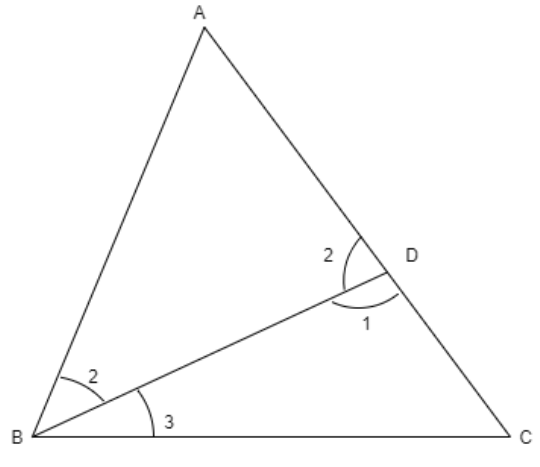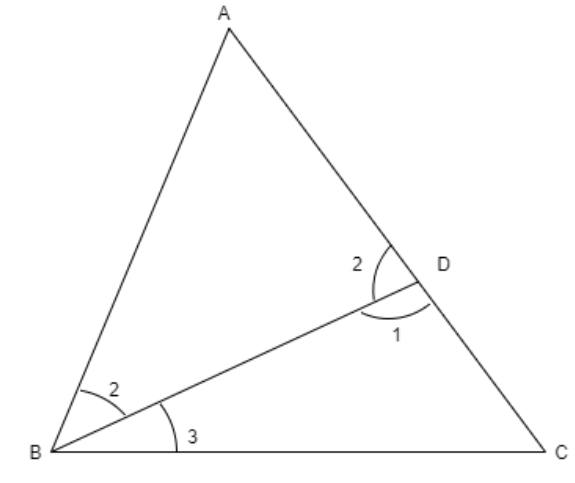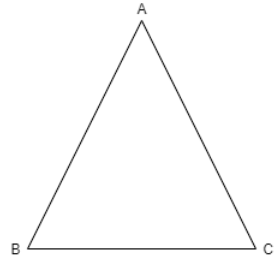Answer
391.5k+ views
Hint: We solve this problem by constructing an isosceles triangle within the general triangle that is as shown below.

Here, \[AB=AD\] we know that the angles opposite to equal sides are equal and the exterior angle is equal to the sum of opposite two angles. By using these two theorems we need to prove \[DC< BC\] which gives the required result.
Complete step-by-step solution:
Let us consider a triangle \[\Delta ABC\]
Now, let us construct the side \[BD\] such that \[AB=AD\] as shown below

We know that the angles opposite to equal sides are equal.
By using the above theorem we can write
\[\angle ABD=\angle ADB=\angle 2\]
We know that the exterior angle is equal to the sum of the opposite angles.
By using the above theorem we can write
\[\begin{align}
& \Rightarrow \angle BDC=\angle A+\angle ABD \\
& \Rightarrow \angle 1=\angle A+\angle 2 \\
\end{align}\]
Here, we can see that we need to add \[\angle A\] to \[\angle 2\] for getting \[\angle 1\]
So, from the inequality we can write
\[\Rightarrow \angle 1> \angle 2.....equation(i)\]
Now, similarly let us go for \[\Delta DBC\] that is
\[\begin{align}
& \Rightarrow \angle ADB=\angle C+\angle DBC \\
& \Rightarrow \angle 2=\angle C+\angle 3 \\
\end{align}\]
Here, we can see that we need to add \[\angle C\] to \[\angle 3\] for getting \[\angle 2\]
So, from the inequality we can write
\[\Rightarrow \angle 2 >\angle 3.....equation(ii)\]
Now, by combining the equation (i) and equation (ii) we get
\[\begin{align}
& \Rightarrow \angle 1> \angle 2> \angle 3 \\
& \Rightarrow \angle 1> \angle 3 \\
& \Rightarrow \angle 3<\angle 1 \\
\end{align}\]
We know that we can replace the sides in an inequality with their opposite angles and vice versa.
By using the above theorem we can take the sides opposite to \[\angle 3\] and \[\angle 1\] from \[\Delta DBC\] to get
\[\begin{align}
& \Rightarrow \angle 3< \angle 1 \\
& \Rightarrow DC< BC \\
\end{align}\]
Here, we have the length \[DC\] can be written as
\[\Rightarrow AC-AD< BC\]
Now, by substituting \[AB=AD\] in above equation we get
\[\Rightarrow AC-AB< BC\]
Therefore, we can see that the difference of two sides is less than the third side.
Hence the required result has been proved.
Note: The explanation for the above question can be done in another way also.
We know that the definition of a triangle as the polygon having three sides such that the sum of any two sides is greater than the third side.
Let us consider a triangle \[\Delta ABC\]

From the definition of triangle, we can write
\[\Rightarrow AB+BC>AC\]
Now, the above equation can be reformed as
\[\Rightarrow AC-BC< AB\]
Therefore, we can say that the difference between two sides is less than the third side.
Similarly, we can say for all sides.

Here, \[AB=AD\] we know that the angles opposite to equal sides are equal and the exterior angle is equal to the sum of opposite two angles. By using these two theorems we need to prove \[DC< BC\] which gives the required result.
Complete step-by-step solution:
Let us consider a triangle \[\Delta ABC\]
Now, let us construct the side \[BD\] such that \[AB=AD\] as shown below

We know that the angles opposite to equal sides are equal.
By using the above theorem we can write
\[\angle ABD=\angle ADB=\angle 2\]
We know that the exterior angle is equal to the sum of the opposite angles.
By using the above theorem we can write
\[\begin{align}
& \Rightarrow \angle BDC=\angle A+\angle ABD \\
& \Rightarrow \angle 1=\angle A+\angle 2 \\
\end{align}\]
Here, we can see that we need to add \[\angle A\] to \[\angle 2\] for getting \[\angle 1\]
So, from the inequality we can write
\[\Rightarrow \angle 1> \angle 2.....equation(i)\]
Now, similarly let us go for \[\Delta DBC\] that is
\[\begin{align}
& \Rightarrow \angle ADB=\angle C+\angle DBC \\
& \Rightarrow \angle 2=\angle C+\angle 3 \\
\end{align}\]
Here, we can see that we need to add \[\angle C\] to \[\angle 3\] for getting \[\angle 2\]
So, from the inequality we can write
\[\Rightarrow \angle 2 >\angle 3.....equation(ii)\]
Now, by combining the equation (i) and equation (ii) we get
\[\begin{align}
& \Rightarrow \angle 1> \angle 2> \angle 3 \\
& \Rightarrow \angle 1> \angle 3 \\
& \Rightarrow \angle 3<\angle 1 \\
\end{align}\]
We know that we can replace the sides in an inequality with their opposite angles and vice versa.
By using the above theorem we can take the sides opposite to \[\angle 3\] and \[\angle 1\] from \[\Delta DBC\] to get
\[\begin{align}
& \Rightarrow \angle 3< \angle 1 \\
& \Rightarrow DC< BC \\
\end{align}\]
Here, we have the length \[DC\] can be written as
\[\Rightarrow AC-AD< BC\]
Now, by substituting \[AB=AD\] in above equation we get
\[\Rightarrow AC-AB< BC\]
Therefore, we can see that the difference of two sides is less than the third side.
Hence the required result has been proved.
Note: The explanation for the above question can be done in another way also.
We know that the definition of a triangle as the polygon having three sides such that the sum of any two sides is greater than the third side.
Let us consider a triangle \[\Delta ABC\]

From the definition of triangle, we can write
\[\Rightarrow AB+BC>AC\]
Now, the above equation can be reformed as
\[\Rightarrow AC-BC< AB\]
Therefore, we can say that the difference between two sides is less than the third side.
Similarly, we can say for all sides.
Recently Updated Pages
Three beakers labelled as A B and C each containing 25 mL of water were taken A small amount of NaOH anhydrous CuSO4 and NaCl were added to the beakers A B and C respectively It was observed that there was an increase in the temperature of the solutions contained in beakers A and B whereas in case of beaker C the temperature of the solution falls Which one of the following statements isarecorrect i In beakers A and B exothermic process has occurred ii In beakers A and B endothermic process has occurred iii In beaker C exothermic process has occurred iv In beaker C endothermic process has occurred

The branch of science which deals with nature and natural class 10 physics CBSE

The Equation xxx + 2 is Satisfied when x is Equal to Class 10 Maths

Define absolute refractive index of a medium

Find out what do the algal bloom and redtides sign class 10 biology CBSE

Prove that the function fleft x right xn is continuous class 12 maths CBSE

Trending doubts
What is BLO What is the full form of BLO class 8 social science CBSE

Difference between Prokaryotic cell and Eukaryotic class 11 biology CBSE

Difference Between Plant Cell and Animal Cell

Fill the blanks with the suitable prepositions 1 The class 9 english CBSE

Give 10 examples for herbs , shrubs , climbers , creepers

Fill the blanks with proper collective nouns 1 A of class 10 english CBSE

Change the following sentences into negative and interrogative class 10 english CBSE

What organs are located on the left side of your body class 11 biology CBSE

What is pollution? How many types of pollution? Define it



